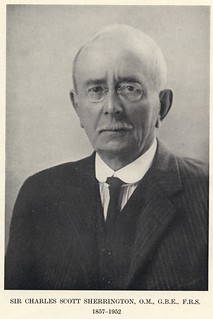One of Sherrington’s greatest interests was without doubt cortical localization. This can be seen by the number of slides showing preparations of cat brains in which lesions had been induced and the degenerated fibres stained.
His curiosity into this topic started when he was a medical student at the University of Cambridge working with John Newport Langley, his college tutor, from 1882 to 1884. In 1881 a debate between Friedrich Leopold Goltz and David Ferrier at the meeting of the Physiological Section of International Medical Congress started the collaboration between Sherrington and Langley and with this Sherrington’s introduction to neurological work. Goltz argued that a dog with lesions to the motor cortex exhibited little paralysis and thus there was no localization of motor and sensory functions in the cortex. On the other hand, Ferrier had induced similar lesions in the motor cortex of a monkey, which as a result showed localized paralysis and thus he maintained the idea of motor functions being localized to particular cortical regions. Following this, a panel of four scientists (William Gowers, Edward Emanuel Klein, Edward Albert Schäfer and John Newport Langley) were to examine the brains of the animals on which Goltz and Ferrier based their research. Sherrington and Langley worked together on Goltz’s dog and at the 1884 meeting of the Physiological Society they presented their analysis. Their results showed that there is a correlation between the neural degeneration with the location of the lesions. They had observed that not all of the corticospinal projections had degenerated. Thus, Goltz’s dog only showed little paralysis as most of the motor functions were formed by the projections that were still intact. On the other hand, Ferrier’s monkey had complete lesions and thus showed complete localized paralysis. Therefore, Sherrington’s and Langley’s observations supported Ferrier’s idea of cortical localization.
This introduction to spinal cord research influenced Sherrington’s future area of research, as he worked with Albert S. F. Grünbaum at the University of Liverpool in 1895-1913. Together, they created the first maps of cortical localization of motor function in primates. Furthermore, there are several samples in the box which are derived from Gustav Theodor Fritsch, who is best known for his discovery with Hitzig of the motor centres of the cerebral cortex.
Through Langley, Sherrington was introduced to neurological work to which he devoted his whole life afterwards and finally receiving the Nobel Prize in Physiology or Medicine in 1932 for his work on spinal reflexes and inhibition.
Zoltán Molnár, Richard E. Brown, Insights into the life and work of Sir Charles Sherrington, Nature Reviews Neuroscience 11, 429-436 (June 2010)
Sir Charles Sherrington – Biographical, Nobel Media AB 2014: http://www.nobelprize.org/nobel_prizes/medicine/laureates/1932/sherrington-bio.html
Todman, DH (2008) History of Neuroscience: John Newport Langley (1852-1925), IBRO History of Neuroscience: http://ibro.info/wp-content/uploads/2012/12/Langley-John-Newport.pdf
- No links match your filters. Clear Filters



















